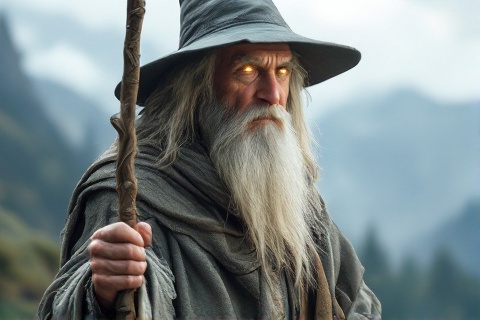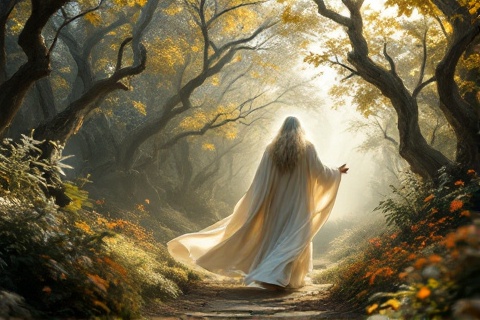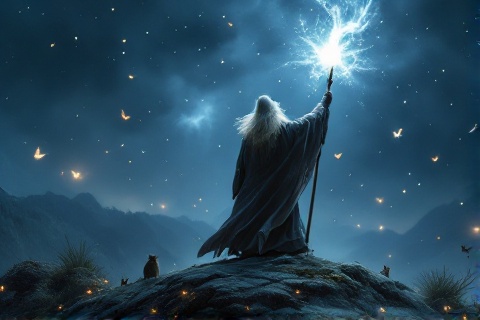
Gandalf: Wizard, Guide, Guardian
A Brief Look at Middle-earth's Most Mysterious Istari
Origins in Valinor

In the blessed realm of Valinor, before the creation of
Middle-earth, there dwelt a Maia spirit
known as Olórin, who would later be called Gandalf by mortal peoples. Among all
the Maiar, he was renowned for his deep wisdom and understanding, spending much
time in the gardens of Lórien where he would walk unseen among the Eldar,
sending them fair visions and planting wisdom in their minds.
Olórin's greatest teacher was the Vala Nienna, sister of the
Valar Mandos and Lórien. Under her tutelage in her halls in the
far west of Valinor, he learned patience, pity, and the wisdom that comes from
understanding sorrow. These lessons would prove invaluable during his later
mission in Middle-earth, shaping his approach to helping others and his
understanding of the burdens carried by the Free Peoples.
When the Valar grew concerned about Sauron's growing power
in Middle-earth during the Third Age, they chose five Maiar to
journey across the sea as the Istari, or Wizards. Olórin was
selected despite his own humility and reluctance, for Manwë, the Elder King,
knew his wisdom would be crucial in the coming struggles. He was the last of the
five to arrive in Middle-earth, yet would prove to be the greatest of the order.
The Grey Pilgrim's Appearance
Throughout his time in Middle-earth, Gandalf became instantly recognizable by
his distinctive appearance as an elderly man in grey robes, earning him the name
Gandalf the Grey among the peoples of the North. His traditional garb included
weathered grey robes, a wide-brimmed blue hat, and a silver scarf, all of which
became legendary among those who knew him. This simple attire belied his true
nature and power, serving as a humble disguise that allowed him to move freely
among all peoples.
Upon his finger, Gandalf bore Narya, one of the three Elven Rings of
Power, given to him in secret by Círdan the
Shipwright upon his arrival at the Grey
Havens. The Ring of Fire, as it was known, had the power to kindle hope and
courage in the hearts of others, while also protecting its bearer from the
weariness of time. Gandalf kept this ring hidden throughout his mission,
revealing its presence only after Sauron's final defeat.
Among his most notable possessions were his wizard's staff, the symbol and focus
of his magical authority, and the legendary sword
Glamdring. The sword, which he discovered in a
troll-hoard alongside Bilbo's Sting, was an ancient
blade of Gondolin that glowed blue in the presence of orcs.
These implements served as both tools and weapons, though Gandalf preferred to
use them sparingly and with great discretion.
Powers and Abilities

Gandalf's mastery over fire and light was legendary, from creating simple
colored smoke rings to commanding great blazes against his enemies. His powers
included the ability to kindle flame even in the wettest conditions, create
light in the darkest places, and when necessary, unleash devastating magical
fire against his foes. These abilities were demonstrated during his battles with
the Nazgûl on Weathertop and in his confrontation with the
Balrog in Moria.
Through his countless years of existence, first as Olórin in Valinor and then as
Gandalf in Middle-earth, he accumulated vast knowledge of lore, languages, and
the histories of all peoples. His understanding encompassed not only the great
events of ages past but also the smallest details of various cultures, from the
genealogies of the kings of Gondor to the traditions of the
smallest Hobbit communities.
One of Gandalf's most remarkable abilities was his power to inspire hope and
courage in others, even in the darkest of times. This gift was enhanced by Narya
but was also inherent to his nature, allowing him to strengthen the resolve of
those around him without domination or control. His presence alone could dispel
fear and despair, replacing them with determination and valor.
Among his lesser-known but significant powers was Gandalf's ability to
communicate with and command the great eagles of the Misty Mountains,
particularly through his friendship with Gwaihir the Windlord. This mastery
extended to a broader understanding of beast-speech, allowing him to communicate
with various creatures across Middle-earth, though he used this ability
sparingly and only when necessary.
The Wandering Wizard

For over two thousand years of the Third Age, Gandalf wandered the lands of
Middle-earth, rarely staying in one place for long. His travels took him from
the frozen wastes of Forodwaith to the distant lands of Harad, gathering
knowledge and understanding of all the Free Peoples. These journeys allowed him
to establish a vast network of allies and friends, from the highest lords to the
humblest farmers.
Among all the peoples of Middle-earth, Gandalf developed a particular fondness
for Hobbits, recognizing in them qualities that others overlooked. His
friendship with the Shirefolk began during his early wanderings, and he came to
appreciate their resilience, good sense, and unexpected courage. This
understanding would later prove crucial in his choice of Bilbo and Frodo Baggins
for vital roles in the struggle against evil.
Throughout his time in Middle-earth, Gandalf served as both counselor to the
wise and friend to the humble. He was equally comfortable offering advice in the
great halls of Elrond or Galadriel as he was sharing
tales and tobacco with farmers in the Shire. This ability to
bridge different worlds and peoples made him uniquely effective in building the
alliances that would eventually prove crucial in the War of the Ring.
Guardian of Middle-earth
Long before others suspected, Gandalf quietly began investigating the
possibility of Sauron's return to Middle-earth. His research took him to ancient
archives, including the libraries of Minas Tirith, where he discovered crucial
information about the One Ring. These investigations,
conducted in utmost secrecy, would eventually prove vital in identifying the
ring found by Bilbo Baggins.
As a member of the White Council, Gandalf worked alongside the most powerful
Elven lords and his fellow Istari to oppose Sauron's growing
influence. Though Saruman held the position of head of the council, it was often
Gandalf's wisdom that proved most prescient, particularly in his early warnings
about the threat of Dol Guldur and his suspicions regarding Saruman's true
motives.
Rather than seeking to rule or dominate, Gandalf's protection of the Free
Peoples manifested through guidance and counsel. He understood that the peoples
of Middle-earth must choose their own paths and fight their own battles,
offering aid and advice but never attempting to control or command except in
moments of greatest need. This approach set him apart from both Saruman and
Sauron, who sought to dominate and control others.
The Price of Victory

Gandalf's battle with the Balrog of Moria represented the culmination of his
mission as Gandalf the Grey. In the depths of Khazad-dûm,
he faced this ancient evil in a combat that lasted ten days, pursuing the
creature up the Endless Stair to the peak of Celebdil. There, in a final
confrontation, he cast down his enemy but also fell, completing his sacrifice
for the Fellowship.
Through the grace of Eru Ilúvatar, Gandalf was returned to Middle-earth
transformed. As Gandalf the White, he embodied a new level of power and
authority, taking up the role that Saruman had abandoned. His physical form was
changed, his elderly appearance now housing even greater power, though he
retained his essential wisdom and compassion.
With his return as Gandalf the White came enhanced abilities but also a greater
burden of responsibility. He now possessed the authority to command rather than
merely advise, though he used this power sparingly. His wisdom remained his
greatest strength, but it was now coupled with a more direct approach to
confronting the evil threatening Middle-earth.
Legacy of the Grey Pilgrim

Gandalf's greatest victories in Middle-earth came not through direct displays of
power but through his subtle influence on key events and individuals. From his
encouragement of Bilbo's adventure to his guidance of Frodo and the Fellowship,
his actions shaped the course of history through small but crucial
interventions. This approach proved more effective than any show of force could
have been.
Throughout his mission, Gandalf embodied the virtues of wisdom, humility, and
compassion that the Valar had hoped to instill in Middle-earth. Unlike Saruman,
who fell to pride and the desire for power, Gandalf remained true to his
purpose, never seeking to dominate or control but always working to inspire and
guide others toward their own best choices.
After the destruction of the One Ring and the fall of Sauron, Gandalf's mission
in Middle-earth was finally complete. Having fulfilled his purpose, he departed
from the Grey Havens alongside the Ring-bearers, returning at last to Valinor.
His legacy lived on in the Fourth Age through the wisdom he
had shared and the hope he had kindled in the hearts of the Free Peoples.
